Cell-free human immunodeficiency virus type 1 transcytosis through primary genital epithelial cells
- PMID: 17050597
- PMCID: PMC1797244
- DOI: 10.1128/JVI.01303-06
Cell-free human immunodeficiency virus type 1 transcytosis through primary genital epithelial cells
Abstract
Although the transport of human immunodeficiency virus type 1 (HIV-1) through the epithelium is critical for HIV-1 colonization, the mechanisms controlling this process remain obscure. In the present study, we investigated the transcellular migration of HIV-1 as a cell-free virus through primary genital epithelial cells (PGECs). The absence of CD4 on PGECs implicates an unusual entry pathway for HIV-1. We found that syndecans are abundantly expressed on PGECs and promote the initial attachment and subsequent entry of HIV-1 through PGECs. Although CXCR4 and CCR5 do not contribute to HIV-1 attachment, they enhance viral entry and transcytosis through PGECs. Importantly, HIV-1 exploits both syndecans and chemokine receptors to ensure successful cell-free transport through the genital epithelium. HIV-1-syndecan interactions rely on specific residues in the V3 of gp120 and specific sulfations within syndecans. We found no obvious correlation between coreceptor usage and the capacity of the virus to transcytose. Since viruses isolated after sexual transmission are mainly R5 viruses, this suggests that the properties conferring virus replication after transmission are distinct from those conferring cell-free virus transcytosis through the genital epithelium. Although we found that cell-free HIV-1 crosses PGECs as infectious particles, the efficiency of transcytosis is extremely poor (less than 0.02% of the initial inoculum). This demonstrates that the genital epithelium serves as a major barrier against HIV-1. Although one cannot exclude the possibility that limited passage of cell-free HIV-1 transcytosis through an intact genital epithelium occurs in vivo, it is likely that the establishment of infection via cell-free HIV-1 transmigration is a rare event.
Figures
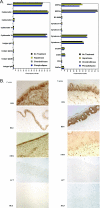
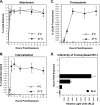
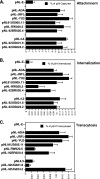
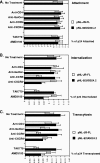
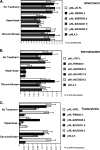
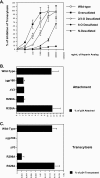
References
-
- Annan, K. A. 2002. In Africa, AIDS has a woman's face. New York Times 29 December p. 9.
-
- Argyris, E. G., E. Acheampong, G. Nunnari, M. Mukhtar, J. K. Williams, and R. J. Pomerantz. 2003. Human immunodeficiency virus type 1 enters primary human brain microvascular endothelial cells by a mechanism involving cell surface proteoglycans independent of lipid rafts. J. Virol. 77:12140-12151. - PMC - PubMed
-
- Auvert, B., A. Buve, B. Ferry, M. Carael, L. Morison, E. Lagarde, N. J. Robinson, M. Kahindo, J. Chege, N. Rutenberg, R. Musonda, M. Laourou, E. Akam, and the Study Group on the Heterogeneity of HIV Epidemics in African Cities. 2001. Ecological and individual level analysis of risk factors for HIV infection in four urban populations in sub-Saharan Africa with different levels of HIV infection. AIDS 15(Suppl. 4):S15-S30. - PubMed
-
- Baba, M., O. Nishimura, N. Kanzaki, M. Okamoto, H. Sawada, Y. Iizawa, M. Shiraishi, Y. Aramaki, K. Okonogi, Y. Ogawa, K. Meguro, and M. Fujino. 1999. A small molecule, nonpeptide CCR5 antagonist with highly potent and selective anti-HIV-1 activity. Proc. Natl. Acad. Sci. USA 96:5698-5703. - PMC - PubMed
Publication types
MeSH terms
Substances
Grants and funding
LinkOut - more resources
Full Text Sources
Research Materials

